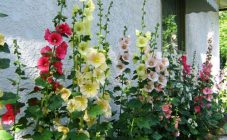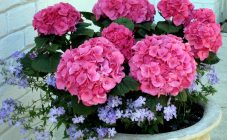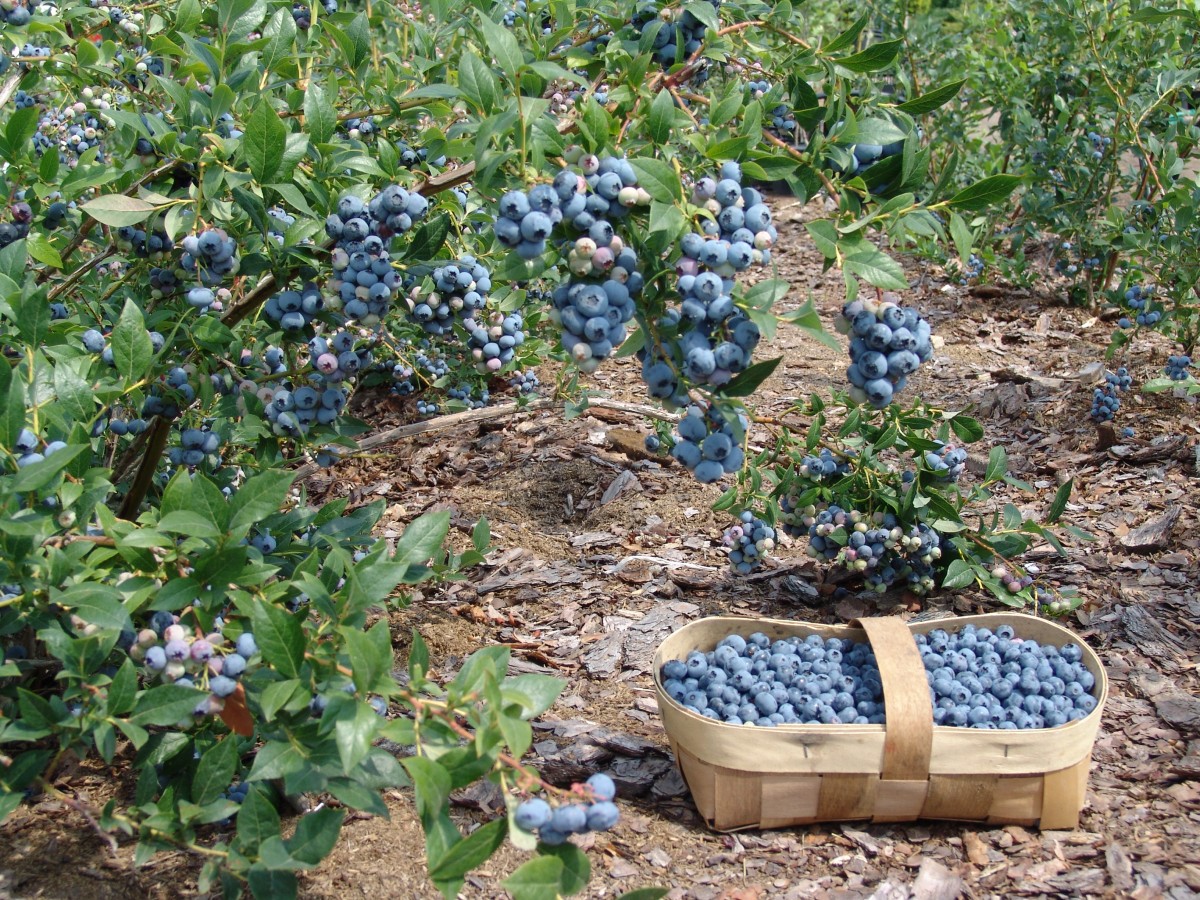Content:
Chamomile is difficult to confuse with another ornamental flowering plant. There are many varieties with bizarre, chic inflorescence shapes, but the harmonious combination of yellow and white flowers in her outfit always remains unchanged. Therefore, daisies in the country will perfectly complement any landscape, making it more spectacular and harmonious.
This article will talk about how to plant perennial chamomiles in a summer cottage, how to properly care for them for abundant and beautiful flowering, and fight pests and diseases.
Large perennial garden chamomile
Large garden chamomile, which flower growers adore so much, has another name - the largest popovnik. Representing a perennial from the Asteraceae family (Asteraceae), this culture has the following botanical description:
- The stem is erect, faceted, depending on the variety, it can have a height of 15 to 70 cm;
- The leaf is spatulate and oblong, unevenly toothed along the edges of the leaf plate. The leaves in the upper part of the stem are relatively small, the lower ones are larger, collected in a basal rosette.
- Color - the inflorescence is a basket, with a diameter of 2.5 to 12 cm, in which the middle consists of small tubular yellow flowers, along the edge there are long false-lingual white flowers.
- The fruit is small, slightly bent cylindrical achenes, up to 2 mm in size.
- Root - taproot, slightly branched, growing shallow in the ground.
Landing
Seeds
You can make the planting material yourself, but for this you have to work hard: after full maturation (the basket and the stem become brown), the inflorescences are cut off, the seeds are selected and dried well. But it is not enough to collect the seeds, they should be stored correctly: paper bags, bags of loose material are best suited for these purposes. The main thing during storage is to provide air access, without it, seed material can lose germination.
Many amateur flower growers do it easier: they buy ready-made chamomile seeds in a store, where you can quickly and easily choose any popular variety, purchase new products of modern breeding.
Landing place
Preparation for planting begins with choosing the most suitable place for growing chamomile on the site. The plant prefers to grow in open areas where there is a lot of light and sun. The occurrence of groundwater should be deep enough, since water accumulation after melting snow and heavy rains can cause waterlogging of the soil, and the rhizome will rot, the plant will die in early spring.
Priming
On the site where they plan to grow chamomile, the soil should be slightly alkaline or neutral. If the acidity index of the soil is high enough, dolomite flour and lime are added to the soil.
How to plant large garden chamomile
When it is decided where the chamomile will flaunt in the country, they begin to plant it.The most favorable time for sowing seeds is the end of May. The top layer of the soil is slightly loosened, since the seeds are very small, then shallow rows are made under them, no more than 2 cm, the soil is slightly moistened. Seeds should not be heavily covered with soil, they are only slightly pressed down, then sprinkled with a thin layer of earth.
In order for adult plants to feel free (usually a bush grows in one place for 3-4 years) and at the same time does not shade each other, the distance between adjacent rows when sowing is made at least 30-40 cm.
You can plant chamomile seeds in open ground in the fall. At the end of August, you should collect seeds from the varieties you like, then sow them in a previously prepared area. The plant blooms only in the second year.
Caring for daisies in the garden
What does a florist need to know and do and how to care for daisies in the garden correctly?
Not only newly planted seedlings need frequent watering, but also early shoots in the open field. Initially, a young plant is watered very often, but when the root system takes root well and gets stronger, it is watered less often, 2 times a week. After watering, the top layer of fertile soil is constantly loosened, do not forget about weeding and removing weeds. Several times a season, the soil near the plant is mulched with a thin layer of peat, 2-3 cm thick.
Top dressing
Like any plant, chamomile needs constant feeding throughout the growing season, for which both complex mineral fertilizers and organic matter are used. In early summer, when the plant is in the budding stage and will soon bloom, it is fed with nitrophos at the rate of 2 tbsp. spoons for 10 liters of water. As soon as the flowering is completed, proceed to the next feeding using superphosphate or potassium sulfate in a proportion of 1 tbsp. spoon for 10 liters of water.
For abundant flowering, organic matter is often introduced: compost, well-rotted manure, peat.
Pruning
Chamomile is a flower that can bloom for a very long time from June to September, but autumn is coming and winter is just around the corner. The plant begins to gradually fade and dry out. Florists often have a question, when daisies have faded, what to do next with them. Experts advise in this situation with garden shears to carefully cut off all the stems at a distance of 10-15 cm from the ground and remove the cut mass away from the planting of the crop.
When and how to transplant chamomile
Experienced flower growers recommend how and when to transplant large chamomiles.
If it is spring, then it is impossible to indicate unambiguously the timing of planting seedlings in open ground, since everything depends on the weather. Seedlings must not only be grown strong, but also protected from cold and frost. When the seedlings are old enough, 4-5 true leaves will bloom on it, then it can be planted in open ground, provided that the air temperature is set at + 15 ° C or more.
Before planting chamomile seedlings in open ground, the soil is well dug up and fertilized with special preparations for flowering garden plants. After that, the bushes must be planted in 2-3 pieces, at a distance of 30-40 cm.
Very often there is such a situation that it is necessary to quickly decide where and when it is better to plant perennial adults chamomile. This happens when a plant is forced to transplant from a flower bed near the house due to construction work or the transfer of a flower garden to another place.Due to the peculiarities of the culture, the way out of this situation is quite simple - this flower is unpretentious and hardy, painlessly takes root in another place. Careful enough so as not to damage the roots, dig up the flowering plant with a clod of earth and move it to a new place, then water it abundantly.
How to propagate garden chamomile
To propagate chamomile, they resort to simple traditional methods:
- seed (growing seedlings from seeds);
- vegetative (dividing the bush).
It is possible to sow seeds both in spring and in autumn directly into open ground, seedlings will appear, but it is more reliable to grow seedlings. In March, seeds are sown in a special soil mixture of peat, garden soil, sand (1: 1: 1). In order not to wash the seeds out of the soil, they are watered carefully, then, to create a greenhouse effect, the container is covered with a film and placed in a dark, warm place. In order not to dry out the soil, it is constantly sprayed with water. As soon as the first shoots appear (this usually happens after 10-12 days), the film is removed, and the boxes are transferred to a sunny place.
Chamomile can multiply by dividing the bush. Despite the ability of chamomile to grow in the same place for several years, it should be periodically (after 4-5 years) renewed. New planting material is being prepared in September. An adult bush is completely dug out of the ground, after which younger root shoots are selected from it for planting.
Diseases and pests
If the flowering crop is not properly cared for, it quickly weakens and becomes most vulnerable to various dangerous infections and pests.
Large garden chamomile can be susceptible to the following diseases:
- rust - convex bright red spots appear on the leaves;
- gray rot, powdery mildew - leaves and stems are covered with a white, dark gray bloom;
- fusarium - causes damage to the root system of the plant.
If the treatment is not started on time, the plant may simply die.
You can quickly cure the disease if you resort to the use of fungicides such as:
- "Oxyhom"
- "Topaz",
- "Discor",
- bordeaux liquid,
- copper oxychloride.
The most dangerous pests of chamomile are aphids, star-winged fly, wireworm, slugs.
For spraying against pests, insecticides such as "Iskra", "Imidor", "Fitoverm" are used.
Growing chamomile in a pot
The article provides examples of how to plant and grow perennial chamomiles in a personal plot. But it turns out that chamomile in a pot can complement a home interior. This is not a giant bush, but a short and compact daisy (another name is pyrethrum), only 10-20 cm high. A well-lit window sill, a small and spacious pot is enough to grow a flower. A nutritious soil for growing pyrethrum is purchased at a store. It blooms for a long time, after pruning it is placed in a bright but cool room and watering is limited. In February, it is again transferred to the heat, but they begin to water it abundantly only when the first buds appear in the root outlet.
Florist tips
- For breeding, it is better to choose a terry variety of garden chamomile, since the flowers are larger and more beautiful, there are always a lot of buds, and at the end of summer, re-flowering is possible.
- Despite the frost resistance and endurance, the flower can freeze out in a winter with little snow, so it is sprinkled with a thick layer of peat, straw, and covered with spruce branches.
- Chamomile gets along well with any ornamental plant: with a beautiful lily and a rose, field poppy and cornflower.
- In the search engine results for the query “large perennial garden chamomile planting and care”, sometimes there are articles devoted to pharmaceutical chamomile, which is, albeit a related, but still completely different medicinal wild plant. The technology of its cultivation and application differs from decorative chamomile. Therefore, you should carefully read the text of the article in order to determine what kind of chamomile (decorative or medicinal) we are talking about.
Garden chamomile is considered not only an adornment of any landscape design, but in many ways it brings love and luck to the house, where households begin to live in peace and harmony. Well combined in height and size with other flower crops, it blends harmoniously with any flower garden, giving it a unique and eye-catching appearance.
















